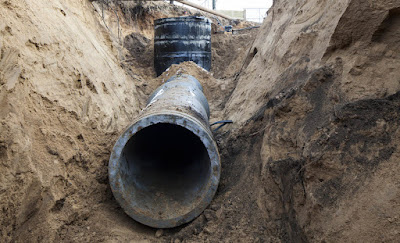North Windham property and business owners learned more about how a new sewer system and wastewater facility will benefit and impact them. Windham town officials and representatives from the Portland Water District updated the group on the timeline and other matters affecting them at a public meeting on May 15 at the Windham Veterans Center.
 |
| Windham's new sewer system will serve the commercial area surrounding Boody's Corner from Franklin Drive (Home Depot) on Route 302 south to River Road. COURTESY PHOTO |
A Clean Water State Revolving Fund subsidized loan, including $3.25 million in grant capacity will be used to pay for the project, according to PWD Engineering & Asset Management Services Manager Greg Pellerin. He said the project also received several million dollars in grants from Environmental Prevention Agency Congressional directed spending, as well as Cumberland County and town American Rescue Plan Act funding.
Windham Assistant Town Manager Bob Burns said U.S. Senators Susan Collins and Angus King were very helpful in securing funding.
Residential property taxes will not be used to pay back the loan, Burns said. Instead, he said, it will be paid back using Tax Increment Finance District funds.
The reason for the project, Pellerin said, is that the town determined “the need for a centralized wastewater collection, treatment, and disposal system due to the limitations septic systems imposed on development, and the environmental concerns related to elevated levels of septic related nutrients measured in the town’s groundwater.”
The sewer collection system will serve the commercial area surrounding Boody’s Corner from Franklin Drive (Home Depot) on Route 302, south to River Road. The new wastewater treatment plant will be located on Sposedo Road south of Manchester School.
In 2020, the town and the PWD formalized an agreement to partner on the project and together with the Maine Department of Environmental Protection worked “to acquire a permit for treated effluent discharge at 154,000 gallons per day (gpd) average daily flow,” Pellerin said. “The WWTF will have an initial permitted capacity of 160,000 gpd average but was designed to be easily expanded in the future. It is configured as a state-of-the-art membrane bioreactor facility, which is designed to provide advanced removal of nitrogen and phosphorus as required by the MDEP permit.”
A request for proposals on who will construct the connections from the properties to the sewer line is currently being advertised and the Town Council will vote to award the contract in the next few weeks.
While properties in the new service area do not have to connect to the new sewer lines, they instead may continue to use their current septic system. However, there are incentives to connect, including having the town pay for the connection from the property to the new pipes, and many are taking advantage of that.
“Businesses have already stopped in to turn in paperwork for connections,” Burns said. He said that those who don’t connect now and decide to do so later will have to pay a substantial cost.
According to Burns, the project is significant not just for the town but also for the state.
“It’s a very big project for the state,” Burns said. “It is unique … in that we don’t see new investment in new treatment plants.” Most were built several decades ago with federal funds that are no longer available, he said.
“It’s a big win for the environment in Windham, for our groundwater resources,” Burns said, “and it will also help out our business community for future development.” <


No comments:
Post a Comment